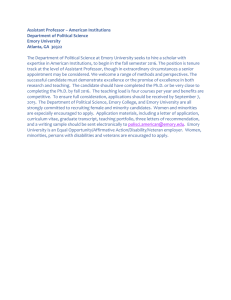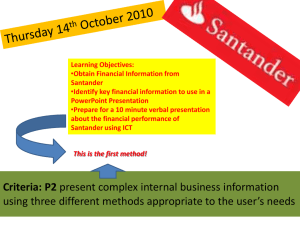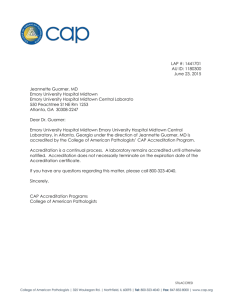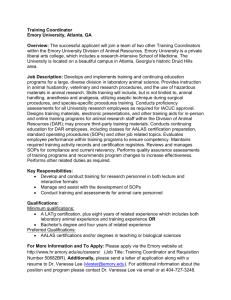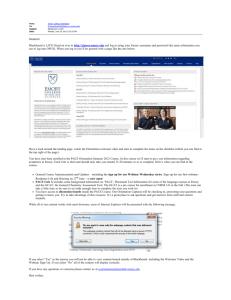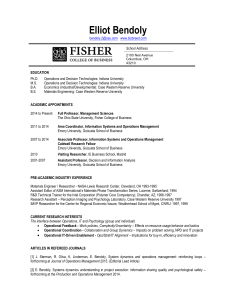HBR_Cases
advertisement
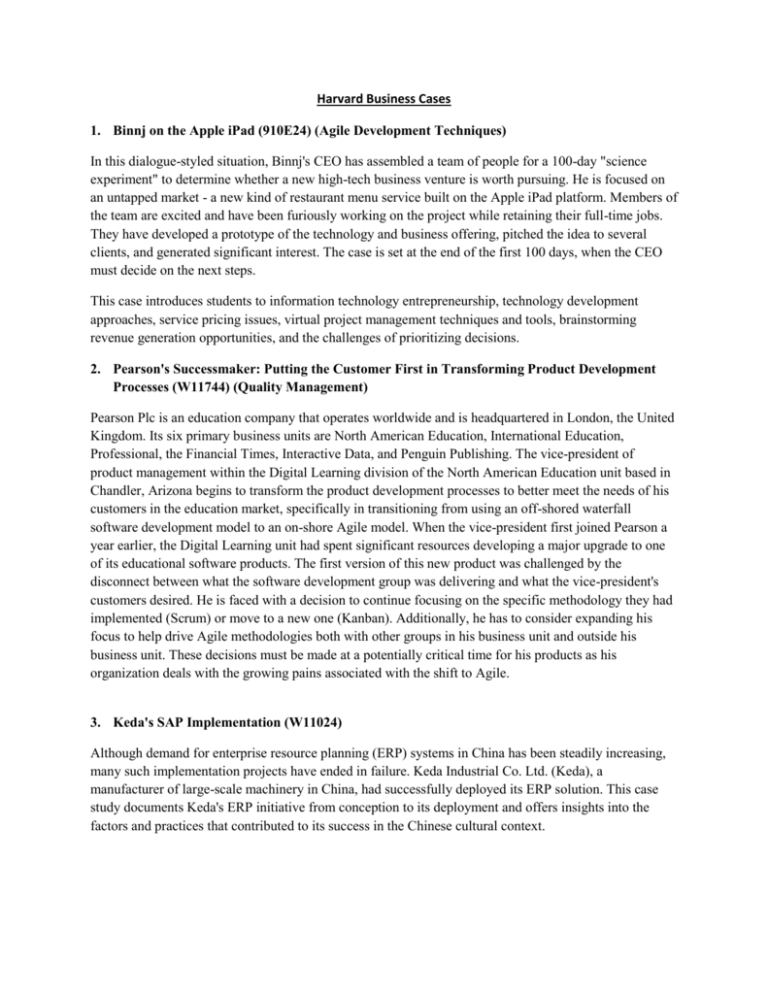
Harvard Business Cases 1. Binnj on the Apple iPad (910E24) (Agile Development Techniques) In this dialogue-styled situation, Binnj's CEO has assembled a team of people for a 100-day "science experiment" to determine whether a new high-tech business venture is worth pursuing. He is focused on an untapped market - a new kind of restaurant menu service built on the Apple iPad platform. Members of the team are excited and have been furiously working on the project while retaining their full-time jobs. They have developed a prototype of the technology and business offering, pitched the idea to several clients, and generated significant interest. The case is set at the end of the first 100 days, when the CEO must decide on the next steps. This case introduces students to information technology entrepreneurship, technology development approaches, service pricing issues, virtual project management techniques and tools, brainstorming revenue generation opportunities, and the challenges of prioritizing decisions. 2. Pearson's Successmaker: Putting the Customer First in Transforming Product Development Processes (W11744) (Quality Management) Pearson Plc is an education company that operates worldwide and is headquartered in London, the United Kingdom. Its six primary business units are North American Education, International Education, Professional, the Financial Times, Interactive Data, and Penguin Publishing. The vice-president of product management within the Digital Learning division of the North American Education unit based in Chandler, Arizona begins to transform the product development processes to better meet the needs of his customers in the education market, specifically in transitioning from using an off-shored waterfall software development model to an on-shore Agile model. When the vice-president first joined Pearson a year earlier, the Digital Learning unit had spent significant resources developing a major upgrade to one of its educational software products. The first version of this new product was challenged by the disconnect between what the software development group was delivering and what the vice-president's customers desired. He is faced with a decision to continue focusing on the specific methodology they had implemented (Scrum) or move to a new one (Kanban). Additionally, he has to consider expanding his focus to help drive Agile methodologies both with other groups in his business unit and outside his business unit. These decisions must be made at a potentially critical time for his products as his organization deals with the growing pains associated with the shift to Agile. 3. Keda's SAP Implementation (W11024) Although demand for enterprise resource planning (ERP) systems in China has been steadily increasing, many such implementation projects have ended in failure. Keda Industrial Co. Ltd. (Keda), a manufacturer of large-scale machinery in China, had successfully deployed its ERP solution. This case study documents Keda's ERP initiative from conception to its deployment and offers insights into the factors and practices that contributed to its success in the Chinese cultural context. 4. Providian Trust A (398008-PDF-ENG) A major trust company attempts to implement a major software system while simultaneously reengineering business processes. Providian Trust, a previously non-IT intensive organization, must completely reposition its management of technology to deal with IT's new strategic role in the company. The case illustrates how the appropriate use of IT framework can illuminate risk and suggests appropriate courses of action. 5. Volkswagen of America: Managing IT Priorities (606003) [Time Management] Describes the efforts of Volkswagen of America, the U.S. subsidiary of Volkswagen AG, to arrive at a process for setting IT funding priorities so that they align with business priorities and the company's overall strategy. The process is carefully thought out and executed, but still encounters difficulties. Demonstrates the details and difficulties of setting priorities for use of a scarce organizational resource. Provides opportunities to critique the company's efforts and to propose alternative approaches. 6. Reinventing the Practices of Distance Information Systems Development: CGI and the Hubble Project - Part A (HEC001) [Risk and HR Management] This case study delves into the challenges faced by CGI, which has just signed an agreement for a major project involving the development of information systems for a client in Los Angeles. We sit in on the meetings of the members of the project team as they make important decisions on the main project management and execution parameters. Part A introduces readers to the actors and the project, while exposing the context and the challenges facing this project. Part B illustrates the decisions made by CGI regarding the project's organization and the competencies of the team members, with a specific focus on the innovative development methodology adopted by CGI in response to the specific characteristics of this project. 7. Successfully Navigating the Turbulent Skies of a Large-Scale ERP Implementation (HEC035) Enterprise resource planning (ERP) systems introduce changes on a larger scale than most other systems. They link various components of the organization and modify its structure by deploying standardized processes and data models, which can lead to higher efficiency and significant cost savings. This case shows the adjustment dynamic between an ERP system and the other components of the organization. The project is a very large one, involving an investment of several hundred million dollars. The results are impressive. Bombardier implemented new processes through the use of the system, changed the roles of its employees, created a different way of looking at the organization and its activities and established new value indicators that helped crystallize the new behaviours. 8. MIS America Grupo Santander (NA0262) In February 2005, Jesús Cepeda, Director of Grupo Santander's Management Control Area, reviews a Chilean pilot test of a new management information system, MIS America. Grupo Santander, a global financial institution, had grown rapidly through acquisitions in recent years, giving rise to a great need for reliable, timely information to help Santander managers compare performance across globally distributed units and make better strategic and operational decisions. The pilot test in Chile had suffered numerous delays. Cepeda had to decide what to do next regarding MIS America. The original plan had specified that following the Chile pilot, the new system would be rolled out throughout Latin America, but Cepeda was not sure if he was ready to authorize the rollout. This case study highlights the information systems challenges associated with rapid growth via acquisition. Top executives had an urgent need for both consolidated and precisely disaggregated information. The case also examines questions of centralized versus decentralized control in a corporate MIS that addresses different needs in different Latin American countries, while responding to Grupo Santander's own needs at the corporate level. The challenges presented by this large and complex project are applicable to many IT projects in other industries and geographic settings. 9. Computerized Provider Order Entry at Emory Healthcare [Healthcare IT] The Computerized Provider Order Entry at Emory Healthcare case presents one hospital system's efforts to implement computerized provider order entry (CPOE) across all of its hospitals and the challenges they faced in doing so. Issues such as standardization of care, how to handle medication reconciliation, and unexpected challenges (e.g., changes to the post-op ordering process, lack of a human gatekeeper to monitor order flow, increase in lab orders). Dr. Bill Bornstein, Chief Quality and Medical Officer of Emory Healthcare in Atlanta is responsible for the smooth implementation of CPOE at Emory Healthcare, which is a vital part of their $50 million electronic medical record initiative. By June 2009, CPOE had gone "live" at Emory University Orthopaedics and Spine Hospital, Emory University Hospital, and Wesley Woods Hospital in a staged rollout. While Dr. Bornstein felt good about how the implementation had gone thus far, as he looked ahead next month to July 13, 2009, the fast approaching go-live date for Emory University Hospital Midtown (EUHM), he was concerned about the challenges and possible perils that lay ahead. He considered what additional actions he should take to prepare for go-live at Midtown, and if Midtown was ready for CPOE at all. One thing was certain; this hospital was different. The Computerized Provider Order Entry at Emory Healthcare case presents one hospital system's efforts to grapple with the challenges of implementing CPOE and the reactions that result. Issues such as how to deal with a workforce that has mixed views about the value of implementing such systems, the pros and cons associated with standardization of care, as well as how to deal with unexpected changes to work processes are brought out in the case. The case also allows for discussion of how to plan a phased implementation with adequate time for organizational learning to occur between the time that various sites "go live."

